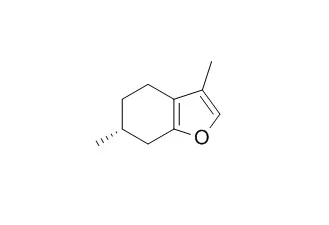| Structure Identification: |
| Proceedings of the National Academy of Sciences of the United States of America, 17 Nov 2003, 100(24):14481-14486. | | Menthofuran regulates essential oil biosynthesis in peppermint by controlling a downstream monoterpene reductase.[Reference: WebLink] | (+)-Pulegone is a central intermediate in the biosynthesis of (-)-menthol, the most significant component of peppermint essential oil. Depending on environmental conditions, this branch point metabolite may be reduced to (-)-menthone en route to menthol, by pulegone reductase (PR), or oxidized to (+)-Menthofuran, by menthofuran synthase (MFS).
METHODS AND RESULTS:
To elucidate regulation of pulegone metabolism, we modified the expression of mfs under control of the CaMV 35S promoter in transformed peppermint plants. Overexpression and cosuppression of mfs resulted in the respective increase or decrease in the production of menthofuran, indicating that the control of MFS resides primarily at the level of transcription. Significantly, in both WT peppermint as well as in all transformed plants, the flux of (+)-pulegone through PR correlated negatively with the essential oil content of menthofuran, such that menthofuran, and pulegone increased, or decreased, in concert. These results suggested that menthofuran itself might influence the reduction of pulegone. Although (+)-Menthofuran did not inhibit (+)-PR activity, stem feeding with menthofuran selectively decreased pr transcript levels in immature leaves, thereby accounting for decreased reductase activity and increased pulegone content.
CONCLUSIONS:
These data demonstrate that the metabolic fate of (+)-pulegone is controlled through transcriptional regulation of mfs and that menthofuran, either directly or indirectly, influences this process by down-regulating transcription from pr and/or decreasing pr message stability. The ability to reduce both menthofuran and pulegone levels is of commercial significance in improving essential oil quality; however, the physiological rationale for such complex regulation is presently unclear. |
|






 Cell. 2018 Jan 11;172(1-2):249-261.e12. doi: 10.1016/j.cell.2017.12.019.IF=36.216(2019)
Cell. 2018 Jan 11;172(1-2):249-261.e12. doi: 10.1016/j.cell.2017.12.019.IF=36.216(2019) Cell Metab. 2020 Mar 3;31(3):534-548.e5. doi: 10.1016/j.cmet.2020.01.002.IF=22.415(2019)
Cell Metab. 2020 Mar 3;31(3):534-548.e5. doi: 10.1016/j.cmet.2020.01.002.IF=22.415(2019) Mol Cell. 2017 Nov 16;68(4):673-685.e6. doi: 10.1016/j.molcel.2017.10.022.IF=14.548(2019)
Mol Cell. 2017 Nov 16;68(4):673-685.e6. doi: 10.1016/j.molcel.2017.10.022.IF=14.548(2019)